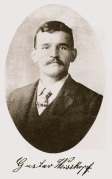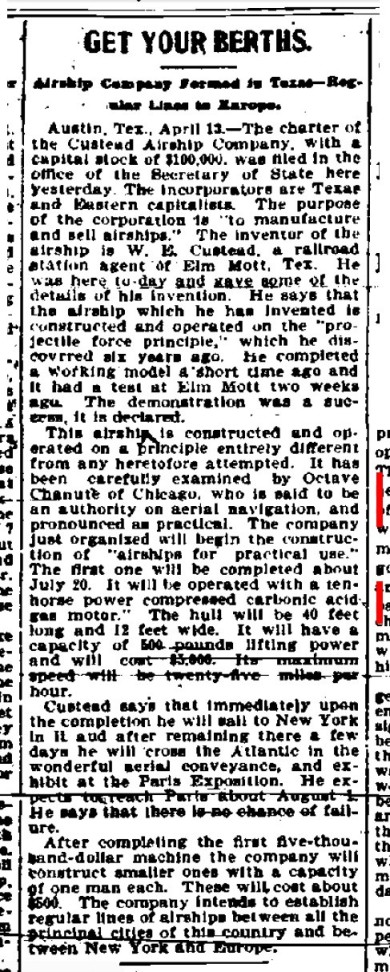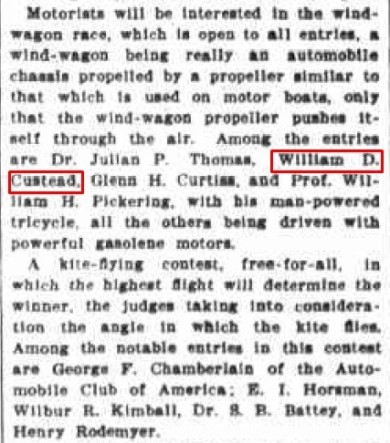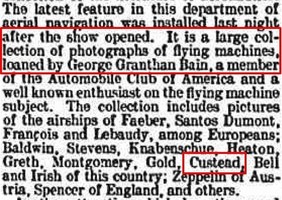The Whitehead-Powered "Custead Airship"
The "Custead Airship" was a "hybrid". Some of its lift was from gas, some from wings and some even from propeller-tilting. Reports state, it flew (which wouldn't have been unusual at the time for a lighter-than-air machine). In the article immediately below, Octave Chanute is said to have examined it and determined that it was airworthy. The company's capitalisation ($100,000) certainly indicates the project was taken seriously.
At the time, dirigable airships were gaining popularity and replacing balloons. Custead's airship appears to have been an attempt to progress further from dirigable airships to winged flying machines. As logical as this may seem, historians have not given him much credit for it so far, probably because the whole idea went nowhere.
Significant about the Custead Airship is not only that it had a Whitehead engine but also when it did. Custead's efforts apparently date from 1897. And in April, 1900, he already had a compressed carbonic gas motor (see article at bottom of page).
Whitehead reportedly used a steam engine in Pittsburgh, 1899. And it was also a Whitehead steam engine which Lawrence Hargrave used in Australia 1900/1901. Whitehead therefore appears to have switched to carbonic gas around the turn of the century which coincides with when he moved to Bridgeport.
Waco Tribune Herald, Centennial Edition, Oct. 30, 1949
McLENNAN AERONAUT BUILT PLANE SIX YEARS BEFORE WRIGHT BROS.
Six years before Orvile and Wilbur Wright lifted their plane off the field at Kitty Hawk in 1903, a quiet little Frenchman, a ticket agent for the Katy railroad, W.D.Custead by name, flew a plane of his own design from Elm Mott to Tokio (McLennan County) and back, a distance of about 5 miles [ ] Those who knew and remember him, such as J.L.Bergstrom of 1502 North Eleventh Street, say that his activities were regarded as those of a person a bit 'off'. But Bergstrom, personally, who knew Custead better than most, referred to Custead as 'brilliant'. Bergstrom was called in to help construct the framework of the plane because of one of his inventions. He had just perfected a brazier by which he could braze or weld two joints of pipe together in rapid time [ ]. The engine of the plane was also a new invention, having been perfected by Gustave Whitehead of Bridgeport, Connecticut. Gasoline engines about this time were heavy, cumbersome affairs containing thick, heavy blocks, large, heavy cylinders, and not capable of creating much horsepower. Whitehead's motor cut down the weight of the normal design and at the same time upped the power. He brought his motor to Elm Mott for Custead to use in the flying machine. Bergstrom said [ ] the only time he saw the plane off the ground was in power test flights held in the field behind Custead's home. Custead would tie four ropes to the four corners of his cockpit, tie the other ends of the ropes to four spring scales anchored in the ground. He would start the motor, rev it up and gradually increase the beat of the wings, amid much noise and smoke. Directly the motor was revved full on, the plane would leave the ground and hover above the test field held from its flight by the four ropes. Bergstrom said the ropes were about 30 feet long and Custead would pull his plane to the lenth of them and then the test would begin to see how much lifting power the plane could develop. Bergstrom said he had read the scales many times and had recorded 200 pounds numerous times during the test. This would amout to about 1,000 pounds actually, counting Custead's and the plane's weight.
Utica Herald Dispatch, April 13, 1900, p.1
New York Morning Telegraph, April 14, 1900, p.11
. "...his first airship will
be completed about June 16. It will be
operated by a ten horse power carbonic
gas motor."
New York World, Sept. 15, 1899
In a related article, Custead advertised for financial backers for his airship in 1899. At the time, he was living in a small town in Pennsylvania:
The exact nature of the contact between Custead and Whitehead at that time is not known.
NY Evening Post, Oct. 31, 1908, p.9
For at least a decade longer, Custead and Whitehead's other associates met on a regular basis. The article below describes a gathering of Whitehead's former bosses, Pickering and Horsman, along with his former and current customers, Custead, Thomas and Curtiss. At the event described at Morris Park, NY , at least one Whitehead-powered aircraft (Beach biplane) and two gliders (Adams/Booth) competed.
Custead on Display
Photos of the Custead Airship were on display in 1906 at the same event where Whitehead also exhibited. The photos were from the George Bantham Bain Collection - now housed at the Library of Congress. Bain was a New York photographer who worked mostly overseas as a foreign correspondent.
Two newspapers report the existence of Custead photos at the first exhibition of the Aero Club of America in January 1906 in New York:









